Related Research Articles
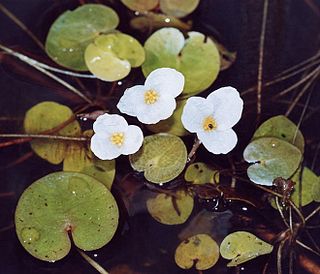
Hydrocharitaceae is a flowering plant family including 16 known genera with a total of ca 135 known species, that including a number of species of aquatic plant, for instance the tape-grasses, the well known Canadian waterweed, and frogbit.

Stratiotes is a genus of submerged aquatic plant commonly known as water soldiers, described as a genus by Linnaeus in 1753. Several specific names have been coined within the genus, but at present only one is recognized: Stratiotes aloides. native to Europe and NW Asia.
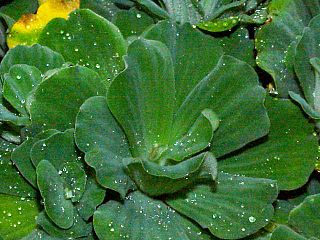
Pistia is a genus of aquatic plants in the arum family, Araceae. It is the sole genus in the tribe Pistieae which reflects its systematic isolation within the family. The single species it comprises, Pistia stratiotes, is often called water cabbage, water lettuce, Nile cabbage, or shellflower. Its native distribution is uncertain but is probably pantropical; it was first discovered from the Nile near Lake Victoria in Africa. It is now present, either naturally or through human introduction, in nearly all tropical and subtropical fresh waterways and is considered an invasive species as well as a mosquito breeding habitat. The genus name is derived from the Greek word πιστός (pistos), meaning "water," and refers to the aquatic nature of the plants. The specific epithet is also derived from a Greek word, στρατιώτης, meaning "soldier," which references the sword-shaped leaves of some plants in the Stratiotes genus.

Stratiotes aloides, commonly known as water soldiers or water pineapple, is a submerged aquatic plant native to Europe and northwestern Asia. In Britain it was once common in East Anglia and still is in many places, particularly wet ditches and healthy ponds. It is the only species in the genus Stratiotes.

Trechus is a genus of ground beetle native to the Palearctic and the Near East. There are more than 1,000 described species in Trechus.

Broscinae is a subfamily of ground beetles in the family Carabidae. There are more than 30 genera and at least 340 described species in Broscinae.

Selenophorus is a genus of beetles in the family Carabidae, first described by Pierre François Marie Auguste Dejean in 1831.

Samea multiplicalis, the salvinia stem-borer moth, is an aquatic moth commonly found in freshwater habitats from the southern United States to Argentina, as well as in Australia where it was introduced in 1981. Salvinia stem-borer moths lay their eggs on water plants like Azolla caroliniana, Pistia stratiotes, and Salvinia rotundifolia. Larval feeding on host plants causes plant death, which makes S. multiplicalis a good candidate for biological control of weedy water plants like Salvinia molesta, an invasive water fern in Australia. However, high rates of parasitism in the moth compromise its ability to effectively control water weeds. S. multiplicalis larvae are a pale yellow to green color, and adults develop tan coloration with darker patterning. The lifespan, from egg to the end of adulthood is typically three to four weeks. The species was first described by Achille Guenée in 1854.
Metius is a genus of beetles in the family Carabidae, containing the following species:

Scaritinae is a large subfamily of beetles in the family Carabidae, containing more than 2400 species in over 140 genera. They are found worldwide.

Ardistomis is a genus of pedunculate ground beetles in the family Carabidae. There are more than 40 described species in Ardistomis, in North, Central, and South America.
Aspidoglossa is a genus of beetles in the family Carabidae. It is found primarily in the Neotropics with one species, Aspidoglossa subangulata, in the United States.
Oxydrepanus is a genus of beetles in the family Carabidae, containing the following species:
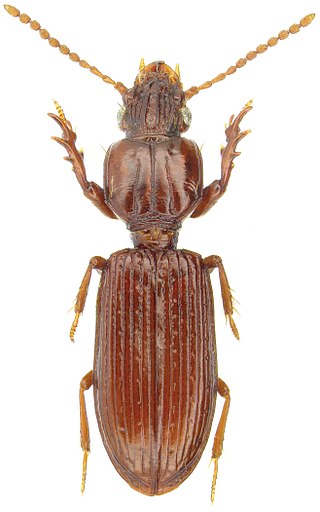
Schizogenius is a genus of beetles in the family Carabidae, containing the following species:
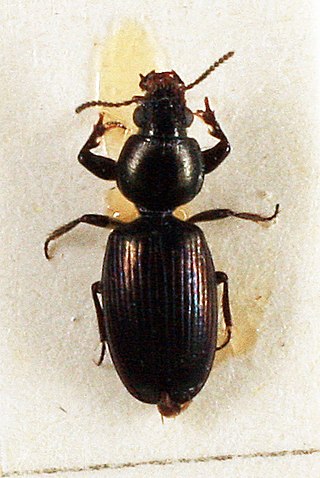
Dyschirius is a genus of beetles in the family Carabidae:
Theodore Palaiologos or Palaeologus, can refer to:
Phaio stratiotes is a moth of the subfamily Arctiinae. It was described by Harrison Gray Dyar Jr. in 1914. It is found in Panama.
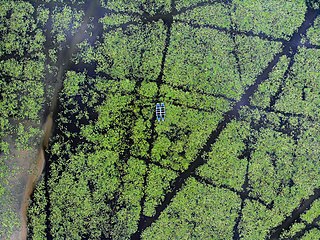
Kondakarla Ava is a famous Lake and Bird Sanctuary in Visakhapatnam of Andhra Pradesh state in South India. It comprises a unique and endangered forest type. It is located in the foothills of Eastern Ghats.
Jules Antoine Adolphe Henri Putzeys was a Belgian magistrate and an entomologist who took a special interest in the beetles belonging to the family Carabidae.

Dendrobium stratiotes is an epiphytic orchid native to the rainforests of New Guinea. It is especially noteworthy for having the longest lasting flowers of any plant, individual flowers at Kew Gardens in Surrey, near London, having remained fresh for as long as nine months.
References
- ↑ "Stratiotes Putzeys, 1846". Catalogue of Life. Retrieved 2023-04-09.